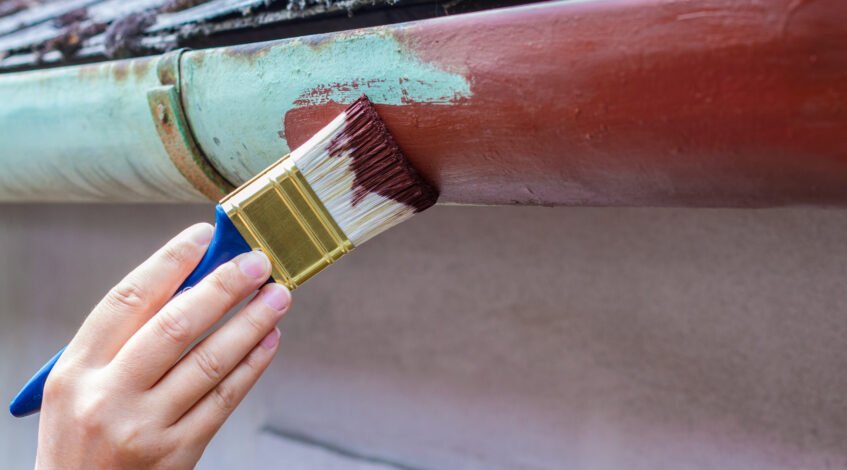Your gutters are one of the most important components of your home’s drainage system, protecting your property from water damage and preserving its structural integrity. However, like any part of your home, gutters require care to stay in top condition. With proper maintenance and a few proactive measures, you can significantly extend the lifespan of your gutters, saving time and money in the long run. Here’s how.
1. Clean Your Gutters Regularly
Why It Matters:
Clogged gutters are one of the leading causes of gutter damage. Debris like leaves, twigs, and dirt can block water flow, causing gutters to overflow and potentially sag or rust over time.
How to Do It:
- Clean your gutters at least twice a year, ideally in the spring and fall.
- Use a scoop, garden trowel, or your hands (with gloves) to remove debris.
- Rinse the gutters with a garden hose to flush out smaller particles.
Pro Tip:
Consider installing gutter guards to reduce the frequency of cleaning by keeping debris out.
2. Inspect for Damage Regularly
Why It Matters:
Early detection of small issues, such as cracks, rust, or loose fasteners, can prevent them from escalating into larger problems.
How to Do It:
- Check for visible signs of wear, such as sagging sections, rust spots, or leaks, during your regular cleaning.
- Look for water stains on siding or pooling water around your foundation, which may indicate gutter issues.
Pro Tip:
Perform inspections after heavy storms to catch storm-related damage.
3. Ensure Proper Slope and Alignment
Why It Matters:
Gutters need the correct slope to direct water toward downspouts. A gutter that is misaligned or sagging can cause water to pool, leading to rust and leaks.
How to Do It:
- Gutters should slope about 1/4 inch for every 10 feet toward the downspout.
- Use a level to check the slope and adjust hangers or brackets as needed.
Pro Tip:
If water isn’t flowing freely, consult a professional to adjust the alignment.
4. Repair Leaks and Holes Promptly
Why It Matters:
Small leaks and holes can quickly worsen, leading to more significant water damage and potentially requiring costly replacements.
How to Do It:
- Use a waterproof sealant or gutter patch kit to fix small leaks.
- Replace severely damaged sections to ensure the gutter system remains effective.
Pro Tip:
Aluminum and vinyl gutters are easier to repair than steel or copper, which may require professional expertise.
5. Reinforce Gutters with Quality Brackets
Why It Matters:
Heavy rain, snow, or debris can strain gutters, causing them to pull away from the fascia. Secure gutters are less likely to sag or detach.
How to Do It:
- Inspect brackets and fasteners to ensure they’re tight and in good condition.
- Add additional hangers if necessary, particularly in areas prone to heavy rain or snow.
Pro Tip:
Install brackets every 2–3 feet for maximum support.
6. Prevent Ice Dams in Winter
Why It Matters:
Ice dams can form when melting snow refreezes in your gutters, causing blockages and potential damage to the gutter and roof.
How to Do It:
- Use heat cables or de-icing systems to prevent ice buildup.
- Ensure your attic is well-insulated to minimize heat loss, which can cause snow to melt unevenly.
Pro Tip:
Clean your gutters thoroughly before winter to reduce the likelihood of ice dams.
7. Redirect Water Away with Downspouts
Why It Matters:
Downspouts that don’t extend far enough from your home can cause water to pool around your foundation, leading to cracks and basement flooding.
How to Do It:
- Install downspout extensions or splash blocks to direct water at least 3–4 feet away from your foundation.
- Ensure downspouts are clear of debris and allow water to flow freely.
8. Upgrade Materials When Needed
Why It Matters:
Gutter materials play a significant role in their longevity. Upgrading to durable materials can reduce the need for frequent maintenance and repairs.
Best Options:
- Aluminum: Lightweight, rust-resistant, and cost-effective.
- Copper: Durable and visually appealing, with a long lifespan.
- Vinyl: Affordable but may require more frequent replacements.
- Steel: Strong but prone to rust without proper coating.
Pro Tip:
Seamless gutters are an excellent upgrade as they reduce the risk of leaks and require less maintenance.
9. Protect Your Gutters with Gutter Guards
Why It Matters:
Gutter guards prevent leaves and debris from entering your gutters, reducing clogs and making cleaning easier.
How to Do It:
- Choose from mesh, foam, or reverse-curve gutter guards based on your needs.
- Install gutter guards during a professional cleaning or when replacing gutters.
Pro Tip:
Invest in high-quality gutter guards to minimize maintenance and maximize durability.
10. Schedule Professional Inspections
Why It Matters:
Even with diligent maintenance, some issues may go unnoticed by the untrained eye. Professionals can spot problems early and recommend cost-effective solutions.
How to Do It:
- Schedule annual inspections by a gutter specialist, especially if your gutters are over 10 years old.
- Opt for professional cleaning if your gutters are difficult to access or heavily clogged.
Conclusion
Extending the lifespan of your gutters comes down to regular maintenance, prompt repairs, and smart upgrades. By keeping your gutters clean, aligned, and well-supported, you can avoid costly replacements and ensure your home remains protected from water damage for years to come.
Looking for more tips on home maintenance? Check out our blog for expert advice and product recommendations!

